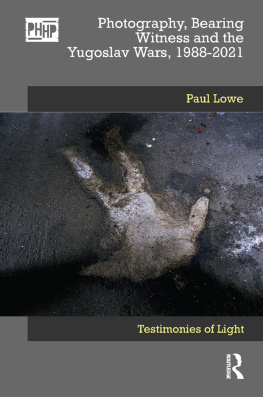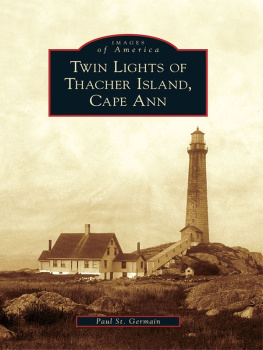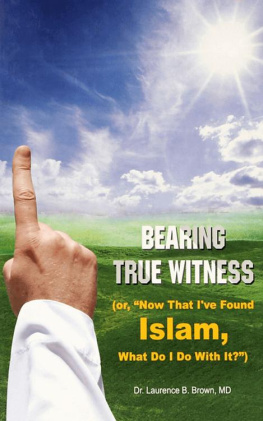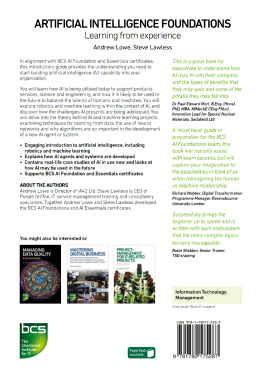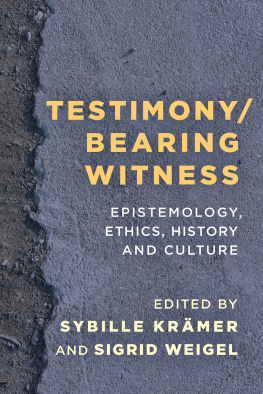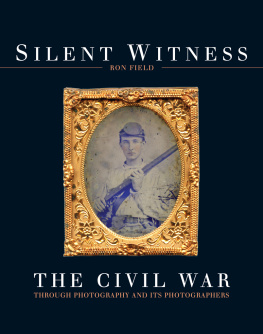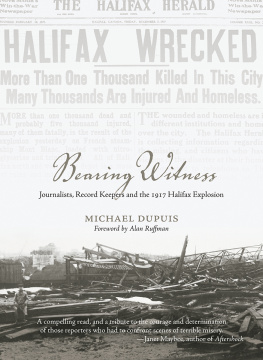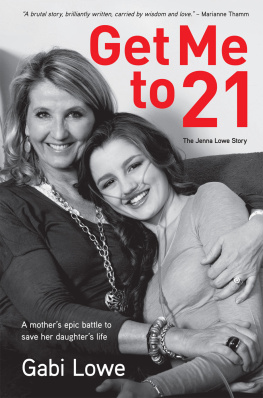Lowe Paul - Photography, Bearing Witness and the Yugoslav Wars, 1988-2021
Here you can read online Lowe Paul - Photography, Bearing Witness and the Yugoslav Wars, 1988-2021 full text of the book (entire story) in english for free. Download pdf and epub, get meaning, cover and reviews about this ebook. year: 2022, publisher: Taylor & Francis Group, genre: Romance novel. Description of the work, (preface) as well as reviews are available. Best literature library LitArk.com created for fans of good reading and offers a wide selection of genres:
Romance novel
Science fiction
Adventure
Detective
Science
History
Home and family
Prose
Art
Politics
Computer
Non-fiction
Religion
Business
Children
Humor
Choose a favorite category and find really read worthwhile books. Enjoy immersion in the world of imagination, feel the emotions of the characters or learn something new for yourself, make an fascinating discovery.
- Book:Photography, Bearing Witness and the Yugoslav Wars, 1988-2021
- Author:
- Publisher:Taylor & Francis Group
- Genre:
- Year:2022
- Rating:5 / 5
- Favourites:Add to favourites
- Your mark:
- 100
- 1
- 2
- 3
- 4
- 5
Photography, Bearing Witness and the Yugoslav Wars, 1988-2021: summary, description and annotation
We offer to read an annotation, description, summary or preface (depends on what the author of the book "Photography, Bearing Witness and the Yugoslav Wars, 1988-2021" wrote himself). If you haven't found the necessary information about the book — write in the comments, we will try to find it.
Lowe Paul: author's other books
Who wrote Photography, Bearing Witness and the Yugoslav Wars, 1988-2021? Find out the surname, the name of the author of the book and a list of all author's works by series.
Photography, Bearing Witness and the Yugoslav Wars, 1988-2021 — read online for free the complete book (whole text) full work
Below is the text of the book, divided by pages. System saving the place of the last page read, allows you to conveniently read the book "Photography, Bearing Witness and the Yugoslav Wars, 1988-2021" online for free, without having to search again every time where you left off. Put a bookmark, and you can go to the page where you finished reading at any time.
Font size:
Interval:
Bookmark:

Combining case studies with theoretical and philosophical insights, this book explores the role of photography in representing conflict and genocide, both during and after the break-up of Yugoslavia.
Concentrating on the photographer, this book considers the practice of photojournalism rather than simply in terms of its consumption and use by the media. The experiences and working methods of photographers in the field are analysed, showing how practitioners conceptualised their work and responded to larger questions about neutrality and moral responsibility. Presenting this active form of witness, author Paul Lowe investigates a crucial ethical paradox faced by photojournalists. Moving beyond the end of the Yugoslav Wars in 2001, this book also considers the therapeutic and validating potential of photography for survivors, featuring photographers whose work centres on memory and reconciliation. Based on archival research, close reading and discourse analyses of photographs, and interviews with a range of international photographers, this book explores how photography from this period has been used and remediated in editorial photojournalism, fine art documentary and advocacy photography.
This book will be of interest to scholars in the history of photography, art and visual culture, and photojournalism.
Paul Lowe is a Reader in Documentary Photography at the London College of Communication, University of the Arts, London, UK.
Series Editors:
Professor Emerita Elizabeth Edwards, De Montfort University, Leicester, UK
Professor Patricia Hayes, University of Western Cape, South Africa
Professor Jennifer Tucker, Wesleyan University, USA
This field-defining series explores the inseparable relationship between photography and history. Bringing together perspectives from a broad disciplinary base it investigates what wider histories of, for example, wars, social movements, regionality or nationhood, look like when photography and its social and cultural force are brought into the centre of analysis.
Photography, Humanitarianism, Empire
Jane Lydon
Victorian Photography, Literature, and the Invention of Modern Memory
Already the Past
Jennifer Green-Lewis
Public Images
Celebrity, Photojournalism, and the Making of the Tabloid Press
Ryan Linkof
Photography and the Making of Eastern Europe
Conflicting Identities, Cultural Heritage (18591945)
Ewa Manikowska
Photographing Tutankhamun
Archaeology, Ancient Egypt, and the Archive
Christina Riggs
Photography, Reconstruction and the Cultural History of the Postwar European City
Tom Albeson
Photography, Bearing Witness and the Yugoslav Wars, 19882021
Testimonies of Light
Paul Lowe
For more information about this series, please visit: https://www.routledge.com/Photography-History-History-Photography/book-series/BLPHOPHHP
Paul Lowe

Cover image: The imprint remains of a Kosovar Albanian burned by Serbian forces in Drenica, Kosovo, June 29, 1999, Ron Haviv, VII Photo.
First published 2022
by Routledge
4 Park Square, Milton Park, Abingdon, Oxon OX14 4RN
and by Routledge
605 Third Avenue, New York, NY 10158
Routledge is an imprint of the Taylor & Francis Group, an informa business
2022 Paul Lowe
The right of Paul Lowe to be identified as author of this work has been asserted in accordance with sections 77 and 78 of the Copyright, Designs and Patents Act 1988.
All rights reserved. No part of this book may be reprinted or reproduced or utilised in any form or by any electronic, mechanical, or other means, now known or hereafter invented, including photocopying and recording, or in any information storage or retrieval system, without permission in writing from the publishers.
Trademark notice: Product or corporate names may be trademarks or registered trademarks, and are used only for identification and explanation without intent to infringe.
British Library Cataloguing-in-Publication Data
A catalogue record for this book is available from the British Library
Library of Congress Cataloging-in-Publication Data
A catalog record for this book has been requested
ISBN: 978-1-474-24375-9 (hbk)
ISBN: 978-1-032-32478-4 (pbk)
ISBN: 978-1-003-08629-1 (ebk)
DOI: 10.4324/9781003086291
Typeset in Sabon
by Apex CoVantage, LLC
For Amra
The border crossing point at Morin in North Eastern Albania in April 1999 was a desolate, bleak and miserable place. Tens of thousands of Kosovan Albanian refugees were being forced over the border by masked paramilitaries as part of the Serbian Governments attempts to expel them and ethically cleanse Kosovo. A long column of desperate men, women and children arrived in a constant stream, having negotiated the no mans land between the two countries, mostly on foot. As they entered Albania, exhausted, hungry and scared, they were met not just by Humanitarian organisations attempting to give them shelter and support, but also dozens of journalists, TV crews and photographers. I was one of this throng of media personnel, but felt deeply conflicted by my own presence. Having covered the wars in the former Yugoslavia for the past ten years, and in particular the siege of Sarajevo, where I had made many friends, I could not help but imagine how these scenes of desperation had been repeated so many times over the years, and how people to whom I had become very close to had perhaps narrowly avoided the same fate or even worse. I questioned myself, asking what was I contributing to this story, what was my justification for being there at all? This moment, and many others in my career as a photojournalist, challenged the foundations of my own practice, epitomising the concerns and worries and experiences of my career to date, as I questioned my presence at this scene, and the contribution I, and possibly my colleagues, were making to the understanding of the story. Were we simply there as professional, paid voyeurs, hoping to make a profit on the sufferings of others? Or were we actively contributing to the debate about the politics of intervention and the response to widespread human rights abuse? What value might our images have at a later date, either as part of the historical record, or even submitted as evidence in a court of law to prosecute crimes against humanity? These moments provided the catalyst for the questions that underpin this book, as I sought to explore the concept of witnessing as an ethical position from which to report on the abuses of the world. This book is my attempt to argue for an important and significant role for photojournalism and documentary photography, based on my own personal experience and practice as well as that of many colleagues, as well as an engagement with the conceptual, philosophical and theoretical aspects of how the visual realm can bear witness to atrocity.
Font size:
Interval:
Bookmark:
Similar books «Photography, Bearing Witness and the Yugoslav Wars, 1988-2021»
Look at similar books to Photography, Bearing Witness and the Yugoslav Wars, 1988-2021. We have selected literature similar in name and meaning in the hope of providing readers with more options to find new, interesting, not yet read works.
Discussion, reviews of the book Photography, Bearing Witness and the Yugoslav Wars, 1988-2021 and just readers' own opinions. Leave your comments, write what you think about the work, its meaning or the main characters. Specify what exactly you liked and what you didn't like, and why you think so.

